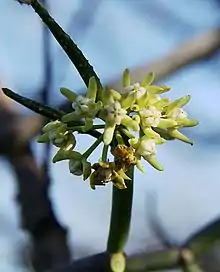Cynanchum viminale
Cynanchum viminale is a leafless succulent plant in the family Apocynaceae. The species is native to West Africa, the Indian Ocean and Western Pacific region. The species' natural range extends from South Africa throughout much of Africa and the Middle East to India, Indochina, Southern China, Indomalaya and into Meganesia.[2][3][4] The species is also found on several Indian Oceans islands including Mauritius, Réunion and the Seychelles.
| Cynanchum viminale | |
|---|---|
 | |
 | |
| Scientific classification | |
| Kingdom: | Plantae |
| Clade: | Tracheophytes |
| Clade: | Angiosperms |
| Clade: | Eudicots |
| Clade: | Asterids |
| Order: | Gentianales |
| Family: | Apocynaceae |
| Genus: | Cynanchum |
| Species: | C. viminale |
| Binomial name | |
| Cynanchum viminale (L.) L. | |
| Synonyms[1] | |
In keeping with its wide distribution, the species is known by a range of common names, including caustic-creeper, caustic bush, sacred soma, soma, rou shan hu,[2] Rapunzel plant, liane calle and kitupa.[3]
Cynanchum viminale is a leafless succulent plant with cylindrical, green photosynthetic stems.[5][6] The plant may grow as a shrub or a scandent vine. The stems produce copious amounts of milky exudate when broken. This exudate is caustic in nature and can cause burns if it contacts human skin. The plant produces small white flowers in clusters. Flowers are followed by long pods which produce numerous seeds with silky plumes that aid in wind dispersal.[5] The environmental range of the species is very broad, extending from rainforest margins and monsoon forests[5] to arid deserts.[3][7]
The plant has been used as a traditional medicine to treat a range of conditions, including sores and wounds, smallpox, eye infections, diarrhoea, intestinal and skin parasites and insufficient milk production.[3][6][8] The aerial parts, roots and latex of the plant are all used for medicine, and the method of use various from ingestion of plant parts, drinking a decoction of the plant, application of the sap to affected parts, exposure to smoke from the burning plant or placing patients onto bedding made from the plant.[3][9] Care is usually required because of the poisonous and caustic nature of the sap, however in some locales toxicity is considered low, at least for part of the year.[3]
Toxicity appears to be variable, even locally. The plant is known to cause poisoning and death in livestock,[3][10][11] but in Kenya it is considered quality forage, and in Somalia and South Africa the stems are eaten by humans, either raw or cooked.[3]
Taxonomy
The taxonomic status of this species is controversial.
The genus Sarcostemma has been shown to be nested within the genus Cynanchum,[12] and Sarcostemma was put into synonymy with Cynanchum in 2002. Thus, Sarcostemma viminale is correctly known as Cynanchum viminale. However this change has not been accepted by all taxonomists and the name Sarcostemma remains in use by a minority,[3][13] despite later genetic evidence.[12]
The species has numerous subspecies, though precisely how many remains in dispute, and this is further complicated by the difficulty in definitively distinguishing C. viminale from closely related species.[12][14][15]
References
- "Cynanchum viminale (L.) L. | Plants of the World Online | Kew Science". Plants of the World Online. Retrieved 2020-03-23.
- "Cynanchum viminale". Germplasm Resources Information Network (GRIN). Agricultural Research Service (ARS), United States Department of Agriculture (USDA). Retrieved 19 January 2018.
- Schmelzer, G. H.; Gurib-Fakim, A.; Arroo, R. R. J.; Bosch, C. H.; de Ruijter, A.; Simmonds, M. S. J. 2008 “Plant Resources of Tropical Africa, Volume 11: Medicinal Plants 1” Backhuys Publishers, Wageningen, Netherlands.
- Robert Pokras; Lucila Calimag & James Facto (1991). "New geographic data on the leafless species of the genus Sarcostemma (Asclepiadaceae)". Israel Journal of Botany. 40 (4): 331–338. doi:10.1080/0021213X.1991.10677211 (inactive 2021-01-10).CS1 maint: DOI inactive as of January 2021 (link)
- http://keys.trin.org.au/key-server/data/0e0f0504-0103-430d-8004-060d07080d04/media/Html/taxon/Sarcostemma_viminale_subsp._brunonianum.htm
- "Archived copy". Archived from the original on 2011-02-24. Retrieved 2014-08-13.CS1 maint: archived copy as title (link)
- Cunningham, G. M., W.E. Mulham, P.L. Milthorpe and J.H. Leigh. 2011. “Plants of Western New South Wales” CSIRO Publishing Collingwood.
- Webb, L. J. 1969 “The Use of Plant Medicines and Poisons by Australian Aborigines” Mankind 7:2
- Latz, P.J. 1995 "Bushfires and Bushtucker: Aboriginal plant use in central Australia" 1995, Oxford Press
- https://repository.up.ac.za/handle/2263/8507
- Kellerman, T. S.; Coetzer, J. A. W.; Naudé, T. W. and Botha, C. J. 2005 Plant poisonings and mycotoxicoses of livestock in Southern Africa – 2nd edition. Oxford University Press, Cape Town. ISBN 0 19 576134 0
- Ulrich Meve & Sigrid Liede-Schumann (2012). "Taxonomic dissolution of Sarcostemma (Apocynaceae: Asclepiadoideae)". Kew Bulletin. 67 (4): 751–758. doi:10.1007/s12225-012-9384-2. S2CID 13307759.
- D. J. Goyder (2008). "Nomenclatural changes resulting from the transfer of tropical African Sarcostemma to Cynanchum (Apocynaceae: Asclepiadoideae)". Kew Bulletin. 63 (3): 471–472. doi:10.1007/s12225-008-9051-9. S2CID 23092665.
- Sigrid Liede-Schumann; Stefan Dötterl; Margit Gebauer; Ulrich Meve (8 July 2012). "A RAPD study of the Sarcostemma group of Cynanchum (Apocynaceae-Asclepiadoideae-Asclepiadeae)". Organisms Diversity and Evolution. 13 (1): 15–31. doi:10.1007/S13127-012-0099-X. ISSN 1439-6092. Wikidata Q56807237.
- Sigrid Liede; Ulrich Meve (May 1993). "Towards an understanding of the Sarcostemma viminale (Asclepiadaceae) complex". Botanical Journal of the Linnean Society. 112 (1): 1–15. doi:10.1111/J.1095-8339.1993.TB00303.X. ISSN 0024-4074. Wikidata Q43304083.